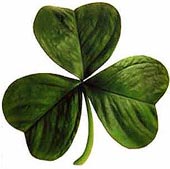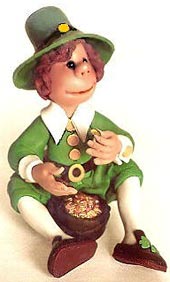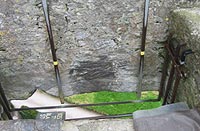|
|
 |
| Home
> Article
> Shamrock, Leprechaun, and Blarney's Stone |
| |
| Shamrock, Leprechaun,
and Blarney's Stone |
| |
 The
Shamrock The
Shamrock
St. Patrick became associated with the shamrock
as he used the three leaf plant to explain the doctrine
of the Holy Trinity to the converts in Ireland.
The association between St. Patrick and the shamrock
developed during years of suppression of Irish Catholics
and the confiscation of their lands.
The first mention of shamrock as a badge is stated
in the 1681 diary of Thomas Dinely, who traveled
throughout Ireland during King Charles II's reign.
He wrote that the 17 March is St. Patrick's feast,
when all the Irish wear crosses in their hats, pins,
green ribbon, and the vulgar superstitiously wear
shamrocks, the three leaf grass which they also
eat to cause a sweet breath. Dinely associated the
wearing of shamrock with the lower social classes.
In the 19th century,
the shamrock became symbolic in other ways as it
became a symbol of rebellion, and anyone wearing
it risked death by hanging. It was this period that
spawned the phrase "the
wearin' o' the green".
Today, the shamrock is the most recognized symbol
of the Irish and is cultivated in Ireland and exported
to USA and Europe to be worn by the Irish and the
honorary Irish on St. Patrick’s Day. |
| |
| The Leprechaun |
 The
Leprechaun is an Irish fairy. He looks like a small,
old man (60 cm tall),
often dressed like a shoemaker, with a cocked hat
and a leather apron. The
Leprechaun is an Irish fairy. He looks like a small,
old man (60 cm tall),
often dressed like a shoemaker, with a cocked hat
and a leather apron.
According to legend, leprechaun is a loner and unfriendly,
live alone, and spend the time making shoes. They
also own a hidden pot of gold. Treasure hunters
can often track down a leprechaun by the sound of
his shoemaker's hammer.
If caught, the leprechaun can be forced to reveal
where his treasure is, but the captor must keep
their eyes on him every second. If the captor's
eyes leave the leprechaun, he disappears and all
hopes of finding the treasure are lost. |
| |
| The Blarney Stone |
The Blarney Stone or the Stone of
Eloquence is a stone situated in the wall of the
Blarney Castle tower in the Irish village of Blarney.
The castle was built by Cormac Laidhiv McCarthy
(Lord of Muskerry)
in 1446. Its walls are 5.5 meter thick.
It is said that people who kiss the stone will be
blessed with the gift of eloquence (blarney).
Legend has it that an old woman cast a spell on
the stone to reward a king who had saved her from
drowning. Kissing the stone  while
under the spell gave the king the ability to speak
sweetly and convincingly. while
under the spell gave the king the ability to speak
sweetly and convincingly.
It is hard to reach the stone since it is situated
between the main castle wall and the parapet. In
order to kiss the stone, people have to stretch
to their back, bend backward and downward, holding
iron bars for support. |
| |
| Back
to other articles |
| |
|
 |
|
|
